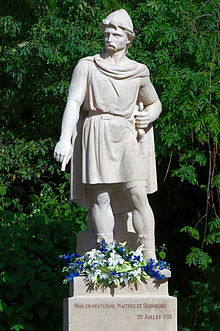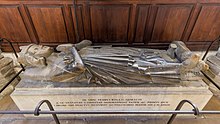Rollo
Rollo (an: Hrólfr or Göngu-Hrólfr) (b. 846; † 931 or 932) is the Frankish Latin name of a Viking who commanded the last major Viking raid on the West Francia in 911. The later Icelandic sagas identify him with Hrolf Ganger (also called Gånge Rolf in Scandinavia), but this attribution is now considered uncertain. Dudo of Saint-Quentin considered him to be a Dane. This statement carries weight, as his informant Raoul d'Ivry was a half-brother of the Norman Duke Richard I. Moreover, he came from England with a Danish contingent.
Allegedly, his name Rollo the Walker comes from the fact that due to his height no horse could carry him and therefore he had to walk the entire land route from Scandinavia to the West Francia. Possibly this was to explain why Rollo in particular was given the territory, although he only called himself Primus inter pares and was actually not even a chieftain. However, excavations have shown that horses in Scandinavia at that time had a withers height of only about 1.1 to 1.3 meters.
He concluded the Treaty of Saint-Clair-sur-Epte with Charles the Simple in 911. Rollo was baptized, since then he called himself Robert. After his baptism, he received a territory on the lower reaches of the Seine as a fief. Flodoard of Reims, who was close in time to the events, does not mention him by name. Rather, he is referred to there as "princeps Normannorum".
The county of Rouen is the origin of today's Normandy. In his first marriage Rollo was married to Poppa of Bayeux. With her he had a daughter, Adele, Duchess of Poitou, and a son, William (900-942). A lament on the latter's death states that he was conceived by a "transmarinus pater" (a father from across the sea) in "errore paganorum permanente" (in permanent pagan error). The chronicler Richer of Reims (888-995), describes him as "dux Rollo, fili Catilli" (Duke Rollo, son of Catillus), a leader of pirates ("pyratae") who ravaged Neustria and the Loire region. In a translational report from this time, he and his Vikings are described as greedy for booty and cruel, they are also accused of torture.
In his second marriage he is said to have married Gisela, a daughter of Charles the Simple. After his death he was buried in the cathedral of Rouen.
His successors called themselves Dukes of Normandy and were integrated into the Christian feudal system of former France. Its directives then also later provided the legal basis for the conquest of England by a successor of Rollo. Rollo is a direct ancestor of William the Conqueror (1027-1087).

Rollo statue in Rouen

The tomb of Rollo in Rouen
Questions and Answers
Q: Who was Rollo?
A: Rollo was a Viking leader.
Q: When did Rollo receive lands around Rouen?
A: Rollo was given lands around Rouen by the Frankish king Charles III the simple in 911.
Q: What did Rollo do with his fief?
A: Rollo passed on his ever growing fief to his descendants, known as the counts and later dukes of Normandy.
Q: What is the House of Normandy?
A: The House of Normandy is the dynasty that Rollo founded and was the first to lead.
Q: When was Rollo born?
A: Rollo was born around 846.
Q: When did Rollo die?
A: Rollo died around 928.
Q: What was Rollo known as besides Rollo?
A: Rollo was also known as Rolf (Hrolf).
Search within the encyclopedia